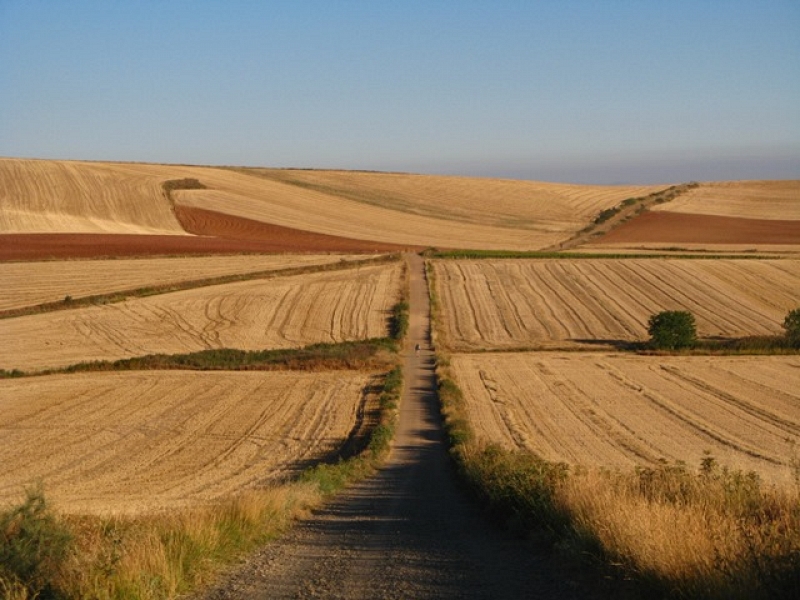Buen camino!
50 kilometres on foot to Santiago de Compostela and inner peace
Who am I? What is my purpose in life? Can I attain balance and peace? Yes, it is possible, I know it. It happens when I travel... though the right word is not travel but journey. In our world of haste people understand travelling as visiting ten countries in twenty days, dozens of museums, tourist sites and beautiful sceneries. After such a vacation I come back home even more tired, my perception of people and places messed up completely, just like everything in the world around us ... Instead of finding my true identity, I forget who I am. That is why I told myself last summer: I am going on foot, no cars, no overcrowded subways, no hurry! I am taking the road to Santiago, which everyone knows as Camino. It is one of the most ancient roads for Christian pilgrims right after the ones to Rome and Jerusalem.
This journey is different. For it you would need a month off, the smallest backpack possible with just the basic necessities, some cash and an adventurous spirit and enough will to walk step by step along the 850-kilometre-long road in Northern Spain. Some use a horse- I look like Pippi Longstocking but I decide it is not my thing. I am not familiar with the art of maintaining a bicycle so I find walking the most "zen" of all. The road is me and I am the road. There are the landscapes, described by Cervantes, Quevedo and Hemingway. I am setting off and I do not know what is awaiting me, when and where I will be sleeping and/or eating, I am wondering whether I will get lost. It looks like a big adventure. Yet everything falls into its place and in the end I have no questions at all- just inner peace and a heart, filled with the incredible sights, meetings and adventures. Camino really is an experience. The road is a symbol of life in its entirety. On the road to Santiago I meet people who cover the distance again and again, some of them even settle here, they find home, love- they turn it into the meaning of their life. The Journey really is the meaning, isn't it?!
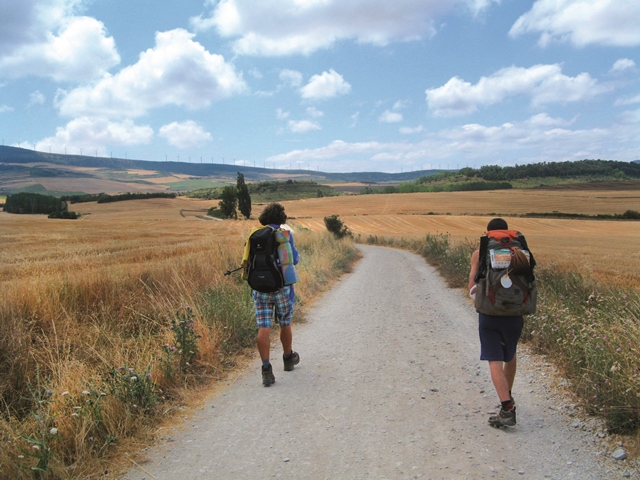
Sometimes you walk with a stranger without talking and that counts as nice and normal. Everyone has their own problems to think about but you are still not alone.
World's end
Saint Jacob, one of the closest disciples of Jesus Christ, spread the Word of God from Jerusalem all the way to Finistere (from Latin- finis terrae - the end of the world) situated on the coast of the Atlantic Ocean. On his way back to the holy lands, Saint Jacob was taken captive and executed. His followers decided to hide his body at the place he had been preaching- at the end of the world. His remains ended in a cave close to Finistere.
In the IX century the shepherd Pelayo noticed a strange light coming from underneath the ground. The rumour spread quickly and reached King Alfonso II who sent his people. They found the cave with a marble column in the middle which was emitting the rays. A chapel was built on the very spot which marked the beginnings of the town of Santiago de Compostela.
When and Who
There are pilgrims taking this route all year round but in winter the backpack is heavier. Most people come in August. I find it most convenient to travel in September as that is the time when there are a lot of wild apples, peaches, blackberries and walnuts along the road, ready to be picked. Furthermore the heat is so unbearable. Anyone who is in good health and wants to, regardless of age and nationality, can go. I meet a Japanese man who is travelling around the world with his children aged 7 and 9. After the earthquake he sold everything and just set off. There are a lot of other people: Bulgarians, who have come here hitchhiking, a grandmother and her granddaughter, some elderly people from Hawaii, a married couple, a mother and her daughter, people, who have found love on their way, priests from Poland or Norway. Most travellers, however, come from Spain, Germany, France, Italy and Brazil.
According to the legend, Saint Jacob was seen by many people after his death. His name is a symbol of rebirth and courage. That is why over the centuries millions of followers have chosen to follow in his footsteps along the road to Santiago. In the past they used the stars for navigation. It is believed that the route starting from the small French village of Saint Jean Pied de Port is a mirror image of the Milky Way.
In the beginning mostly the rich could afford this journey. Many of the travellers lost their lives to decease or robber attacks. Even today there are things that remind us of how it used to be - in my year it was bedbugs. It is a dangerous little bug which usually lives in mattresses but could easily find its way into your backpack for you to carry back home. I do not find this idea appealing so I buy a spray and whenever I go, I put my backpack in a plastic bag to keep it safe.
Following the Islamic invasion in Europe, Santiago was the city where the Reconquista began and that is why it has become a symbol of New Spain. In its cathedral there is a portrait which shows Saint Jacob oppressing the muslins. Nowadays the image is covered with flowers out of respect for the different beliefs.
During the First and Second World Wars the pilgrimage stopped, only to live to its Golden Age, which started in the 70s and has been going on until today.
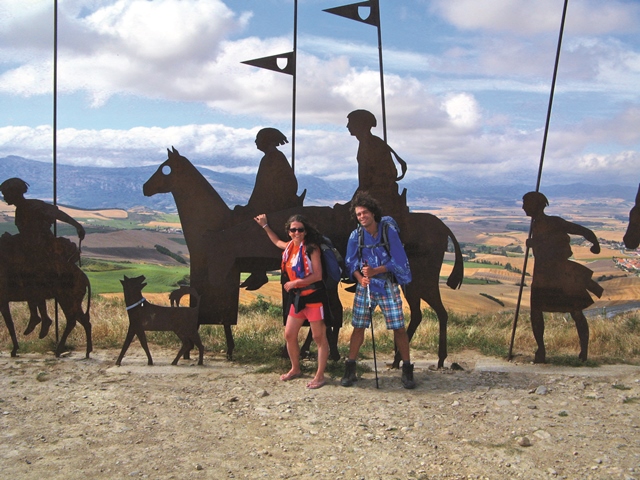
Alto del Perdon- The peak of forgiveness, 735 meters- a windy hill 13 kilometres after Pamplona. Metal sculptures symbolize the never- ending journey with a sign that says: "Where the journey of the wind meets the journey of the stars
Credential
The routes are different, starting from Portugal, Germany, Poland or Madrid and then following the north coast of Spain. The original however is considered to be the one from Saint Jean Pied de Port.
Many people begin their journey on foot from Spain, France, even Germany, because the real pilgrim starts from his home. Of course, there is no way that I could start from "Simeonovsko shose" street and I choose a low-cost flight (worth 70 Euro) to Madrid. From there I take a bus (the ticket costs 22 Euro) to Pamplona. The journey takes five hours and looking out of the window I catch a glimpse of the occasional pilgrim with a backpack and a tourist walking stick. Hooray! I am not the only one. The last trip is to Saint-Jean and although the distance is only 80 kilometres, it takes two hours to cover. In the French village I go to the pilgrims' centre and buy myself a "pilgrim's passport" or the so called credential. Seals are placed here along the way to certify that I have indeed covered all points of the route. In the past the credential offered the travellers certain benefits, for example tax reduction. There are some restaurants even today that offer discounts, too. I put a mussel shell on my backpack- a sign that I am now officially a pilgrim. The tradition dates back to the times when the pilgrims used to take sea shells from the Atlantic coast as a souvenir for their relatives as well as to prove that they had reached the ocean. Now that has been replaced by a certificate in Latin stating you have walked the entire way. Actually, if you only walk the last 100 kilometres (or 200 if you are on a bicycle) you could still get a certificate. That is why the number of pilgrims is visibly higher towards the end. This is a good option if you cannot afford to take 30 days off. A lot of Spanish people travel the route little by little every year depending on the days they get off from work. Luckily I have 25 days, a little bit less than I need but I hope I can manage.
Haste makes waste
Here I am- I am making the first steps. The mussel shell is hanging on my backpack, the credential lies in my pocket and I am eager to meet the unknown which is waiting for me. I know I do not have much time so I hurry and hurry and hurry... As a result my ankle gets swollen on the third day and I have to make a stop. Sitting on some meadow, I decide it is not worth it. From now on I am not going to hurry even if it means not making it to the end.
And this is where the real journey starts and I begin to pay attention to the world around me and its miracles. This is not a race and therefore it is not important to be the first one to finish, but to finish.
My advice for you is to get more than 30 days off. It is better to have a day or two to rest at a place you particularly like or even better - to spend more time with your new-found friends on the road.
And also to spend more time with Him. God is everywhere but here of all places you sense His help and presence. You feel it not only in the numerous cathedrals, cultural and religious monuments which take your breath away; it is art created in the name God in form of gothic sculptures ceilings and frescos. This incredible beauty, the patience and diligence that were required in the making, the style and the ornamentation are an overload to my senses for which they are simply not prepared and I find myself breathless. The cathedral in Burgos is an enormous yet exquisite jewel which your poor senses cannot fully comprehend. The houses of Gaudi in Leon and Astorga, Roman walls, the citadel in Pamplona and many more monuments and monasteries are there to remind us that mankind is capable of miracles.
God is also in the chance meetings, in the attitude of the local people towards you, in the amazing sceneries. If we do not believe in coincidences then here we will be surprised at the miraculous chain of events. Your mind is emptied of all stress, my heart opens, my thoughts calm down and I breathe in the Spirit of God with every step I take.
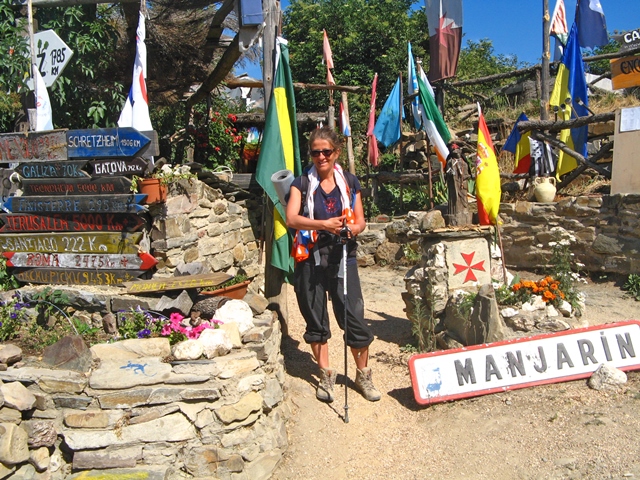
Manharin, a shelter with no running water or electricity but it is believed that everybody who spends the night here is cured of any pain, thanks to the energy the place has. It is true!
A perfect machine
I soon feel the joy that comes from realizing the fact that the only job I will have to do in the next two, three, ten, twenty-five days is walking. This is a job I manage well. I do not have to think constantly about what I have to do, I do not have to make any calls, I just keep walking and I embrace the adventures coming every given moment. At night I have the wondrous feeling that I have achieved something. At first the body resists- ankles and knees begin to swell. That is why it is important to drink a lot of water- otherwise inflammations of the ligaments may occur.
I listen to my body as it is the only thing I have and after a week I feel in awe of the work of God. He has created the perfect machine out of mud – in just a few days my body has adjusted to the weather, the food and my new pace and it can cover 30- 35 kilometres a day even if though it has spent a year sitting behind a desk. My body is strong, fast and healthy - just 10 days after I started I feel like I could go on forever. At this point I understand how some people may cover distances of 3000 kilometres and more.
The original route I follow is wonderful- mountains, vast fields, small villages and big cities, fantastic cathedrals and museums, wilderness- you can find absolutely anything! There are yellow signs marking the way so there is almost no need for maps or guidebooks. All you need is a list with the names of the villages you should visit, the places to sleep and the distances between each one. And that is it.
I follow the signs and I wonder why there are none in real life to indicate the right path.
By chance I hear a mass in a small church. I do not speak Spanish but I understand the language. The pastor calls the route a symbol and a reflection of real life. At first, when you begin climbing the Pyreneans, just like at any new beginning in life, your heart is filled with bravery and great enthusiasm.
Relationships
Everyone says it is best to walk on your own and that turns out to be true. I walk at my own pace, I linger here and there for as long as I want to without having to give reasons or show consideration to others. It is not dangerous to travel alone, besides there is always someone who catches up with you or you approach someone else. We are never alone although sometimes we feel that way. It is easy to make friendships on the way. Someone comes by and we begin talking about the important things in life right away, other times we simply introduce and then go our separate ways. The true power of Camino is not in the cathedrals, the folklore and the priests; it is in the unique friendships we make. What we have in common is the sense of adventure, the need to run away from our everyday lives, the comfort, the system and the matrix; we share a love of freedom, dreams, idealism, loyalty and compassion, to desire to be one with nature, God and the others. With time I start to develop my intuition when it comes to the people. One early morning, when it is still dark, I meet a woman. She moves as a very fast pace but I can tell that she is tired. She asks for my name and I answer "Iva" at which she asks "Iva or Eva?" as if I could make a mistake with my own name. I immediately realize she is a teacher and indeed she really is one. We all greet each other with "Buen Camino!". Although we all speak different languages we understand each other.
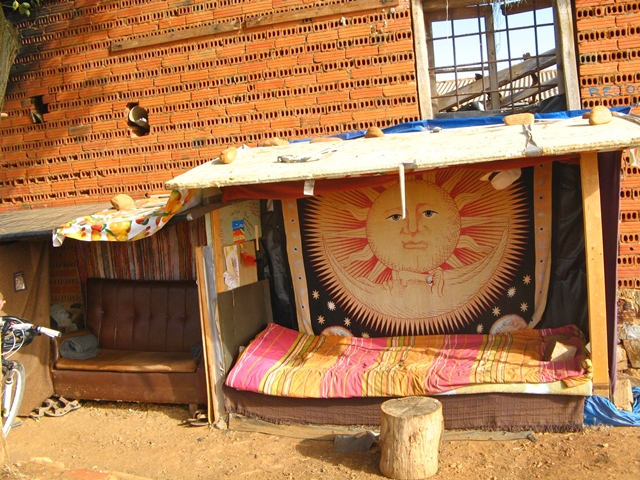
Catering
The first days I have poor appetite and I do not sleep well- maybe I am tired or over-excited. You can eat the so-called "Pilgrim menu" everywhere. It consists of a salad or soup, tortilla or meat/fish with potatoes and a desert. To that you get a bottle of wine (which may eventually prevent you from continuing on your way) and a bottle of water and all of this costs 8-9 Euro. You eat a lot- that is for certain, but fortunately, nothing is accumulated as the calories are all burned. There is usually a kitchen at the albergues where you can cook. If you want to know where the cheapest shops are, just ask the local people. There is always a bar where I buy some huge sandwiches called bogadillos, which have a big variety in taste, some water, coffee, beer or a glass of wine. There are fountains along the way to fill your bottle with fresh water. You do not need more than a litre because the next fountain is not so far away.
There are ups and downs, everything is fresh and interesting and the joy that you have started on this path is great. It is more difficult when you go uphill. Step by step, you reach Spain, the Basque country and Navarra- a beautiful and rich region.
It is the end of July and I get the chance to visit the festivals in honour of Saint Firmin- which includes the famous Bull Chase game which taking place in Pamplona. You can eat and drink to your fill day and night, for a whole week. Everybody wears a red scarf around their necks to pay their respect and honour the sufferings of Saint Firmin.
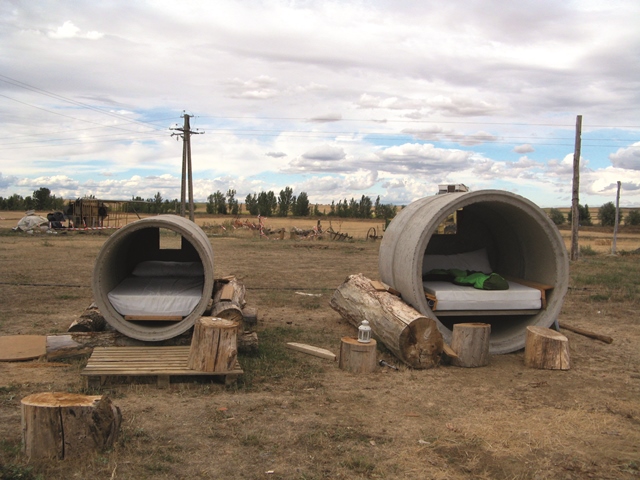
A wine fountain
After Estrea comes La Rioja- a wine region. The place welcomes me with a wine fountain- free of charge! Everybody can fill a glass and try it and whether you are going to fill a whole tube or just a little bit of the magical elixir- it all depends on your conscience. And then you reach endless vineyards and milky-yellow Fields with curious deer running by, plains, small villages... and the heat becomes unbearable. The initial enthusiasm is replaced by sore feet, fatigue, and blisters. It takes persistence and strong will to keep going.
Every night, as soon as I arrive at the hostel, I clean or as they say "stitch up" the blisters. You cannot go without them. The blister is pierced with a needle and a thread, which goes through it and is left there so that the liquid can pour out. Then some iodine is put on it and in the morning it is dry and it does not hurt. One night I am so tired I have no strength left to wash my face, not to mention my blisters. Some boy tells me I must do it and I answer "Tomorrow, now I am going to sleep." "I will take care of them, do not worry." I have no energy to argue so he stitches them while I am asleep. We never meet so that I could thank him. A few days later, however, I take care of the feet of a complete stranger myself.
Some magnificent cities follow: Los Arcos, Logroao and Najera, each one of them having its own historic monuments, sceneries and legends.
There are small villages which are all special in their own way and have unique history. Many of them remind me of a set in a movie as I usually enter during the siesta time. This is a great Spanish "invention" - the heat is so unbearable that life virtually stops between 1pm.and 7pm. and everybody rests. There is the welcoming sight of houses, flowers and a church but it is still life – there are no people. One of the villages, Granon, at first sight appears to be like any other but the locals there have thought of a great ritual. The pilgrims cook whatever they can and then they bring it to the local bakery. The meals are then cooked but in order for us to get it, we must come up with a small performance. That way the locals get to watch a free show every day.
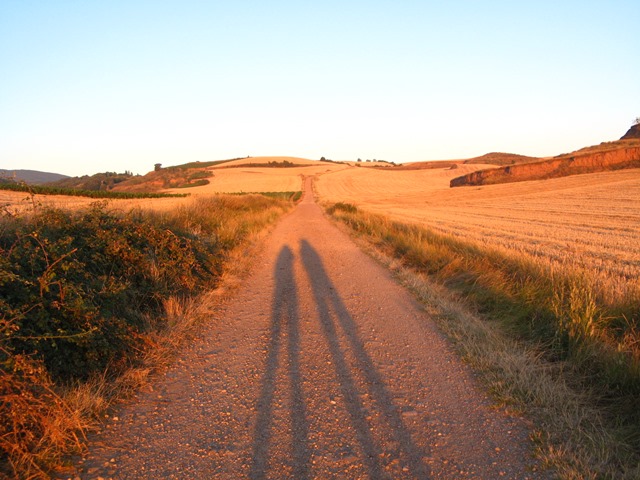
Bogeyman
I get up at 4.30-5 in the morning to avoid the heat.
I also have a midnight walk in a village at full moon, I arrive at around 3 o'clock and I sleep in front of the church- it makes me feel like I am in the Middle Ages. I reach Atapuerca where the remains of the first Europeans were found. They are archaeological evidence that the first settlers on the continent were also cannibals. It is as well the place where the oldest human jaw was also found. After the end of the village you can see a huge metal cross which looks eerie in the light of early morning when the moon is still shining. It is surrounded by spirals of white stones made by the people passing by. It is the break of dawn and it is rather chilly. The path varies between asphalt, dusty roads, wood tracks, stone paths. After 10 kilometres of industrial zone I reach Burgos. Some people are on their way to work, some are taking part in the protests, while others are drinking their morning coffee, and I look like an uncivilized version of Bogeyman- I am carrying a backpack and a walking stick, my face oily with sunscreen and a scarf over my head. Yet, nobody cares.
One of the most beautiful Spanish cities welcomes me the way I am. The city slowly reveals its beauty - its unique cathedral, the "De Las Huelgas" monastery, the arch, its colourful buildings, the small streets bustling with tourists, the magnificent river park... Here, in the city, you could easily tell who is a pilgrim and who is not- even without the tell-tale backpack. It is the walk that gives them away. All the pilgrims walk in the same strange, ungainly, almost ridiculous way because of their blisters and aches.
Messina
Day after day I walk between 25 and 35 kilometres and I realize that no matter how much one day resembles another, they are all unique. Sometimes I sing from the top of my lungs, I talk to myself, I talk to the eagles or I recite poetry. Everyone cries at least once- the catharsis eventually gets you, sooner or later.
You reach the middle of the road, called the messina. It is a 17-kilometer long deserted road- there is no water, no food, no shelter from the sun and no people.

Shelter
We sleep in the so-called alberges. They remind me of our tourist shelters and huts, the rooms usually have bunk beds and belong to the municipality or the church, but there are also private ones. One alberge is housed in a former theatre, another one is run by some hippies and a third one looks like a Mexican farm. It costs 5-10 Euro, the more picky ones can sleep at a hotel, hostel or private accommodation. The alberges have kitchens, showers with hot water, a toilet and sometimes a pool. Usually men and women share a room. The snoring at night is the same in any language- a symphony of tones, so earplugs are a must-have.
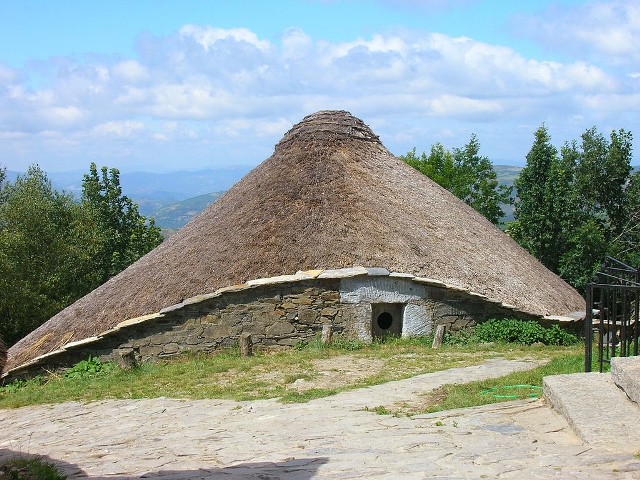
Serbreiro - the common houses for Galicia have straw roofs
Costumes and props
The legend goes that you carry your sins in your backpack. The bigger it is, the more things you are attached to, which weigh you down. The light backpack is a must - there are some wonderful specimens in sport shops to choose from. At the end of the second day I threw away half the things I had packed, I also sent some stuff to friends of mine in Madrid. I fully understand how little is needed to live well. Every night I wash my clothes using soap, if I have one, and the next day I let them dry on my backpack while I am walking. With me I carried a sleeping bag (compact and light-weight), two pairs of shorts, one pair of trousers, two T-shirts, a jacket, raincoat, a pair of shoes, a pair of sandals, two pairs of socks, safety pins (for the clothes drying on your backpack), liquid detergent, a bar of soap, sunscreen, a needle and a thread, a hat. The luggage should not be more than 10% of your own weight. To that you add water, a little bit of food, a notebook and a pen and you are ready. I had also brought three books, two of which I left on the way and I sent the third back. The most important thing are the shoes! They have to be hiking boots so as not to have sore feet. Remember – shoes must be comfortable.
I get the feeling I will never reach the end. There is still a long way to go before I reach my goal, I am starting to lose track of time. My mind is blank and I just walk, following the yellow arrows which point only one way- forward. I have a goal even if it seems unreachable now. In life it is the invariable everyday obstacles and the routine that make me give up when I should not.
I am left alone with myself and I have a lot of time on my hands for sorting my priorities. This is how I usually find the solutions to the various problems of everyday life. Every step I take teaches me to be patient and persistent. Sometimes, when I am soaking wet with sweat, and I am walking across a field without a single tree to offer shade from the beating sun, I wonder why I started all this, why am I doing this to myself while my friends are lying on the beach with a beer in their hand.
Then I meet Minho- a Korean who is travelling along the Camino for the third time. I joke "Why, Minho?" "When you reach Santiago, you'll know" And so it was.
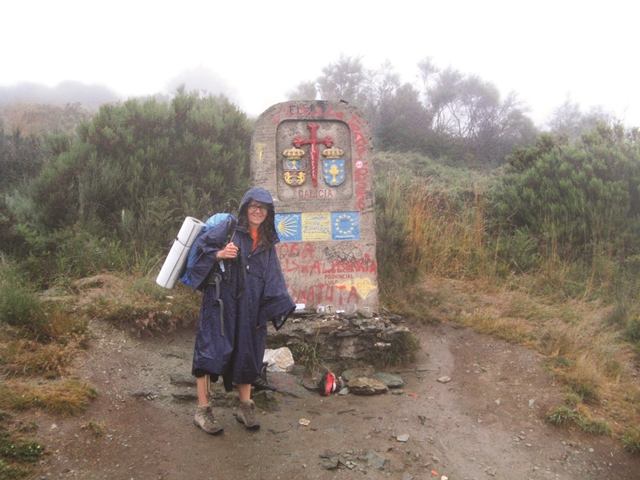
I never give up. I keep walking and every day is like the one before. Costilla and Leon are the regions with the most monotonic landscapes of all, but they also offer the greatest number of historical and cultural monuments in Spain. Leon, for example boasts a beautiful cathedral, some small squares where elderly dressed up ladies are discussing the crisis and men are laughing out loud while drinking cerveza, beautiful young people are walking around and countless flowers are covering the windows. Astorga- there is not a single thing that is not worth taking a shot- the city hall, the clock, the park. The Bishop's palace, built by Gaudi in 1887, is now known as the Camino museum with numerous relics and manuscripts. The lady at the entrance, who checks the tickets, is called... Camino.
Every village has built its own monument dedicated to the pilgrims- such variety and imagination!
Love
Accidentally I hear a sermon given by a Franciscan monk- he immediately wins me over as he reminds me of my favourite teacher- Koko Azaryan. We enter the church and he asks us whether we want to take home the peace we have found on our way to Santiago. We all answer "yes". And he continues: "Which do you think is the symbol of the Christian faith?" Everyone says "The crucifix, the cross", only I say "Love". "If it is the crucifix, then who wants and desires to be crucified? Love is the true power of the Christianity. That is why you should always greet with an open hand, just as you do here. Hold out your hands to the others and even if someone is getting on your nerves, you should encourage them instead of pecking them back." - this is what the monk tells us.
It is as simple as that! A religion so closely connected to real life! Not just a far-fetched sermon but a true connection between faith and life. In order for us to preserve the peace in our hearts we must show our love to our brothers and sisters- it is easy, but we do not always do allow ourselves the liberty to do so.
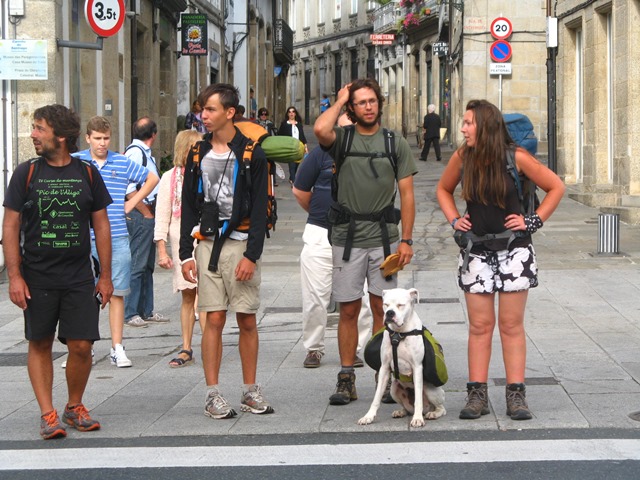
Pedalling
You could also cover the distance on a bicycle for about 10 days. When you arrive in Madrid, the bike gets on the bus with you. You should also take some essentials in case of flat tyres like keys and screwdrivers. You should also train your body for the upcoming 70-80 kilometres a day you are going to cycle every daily. Take some bright and light clothes, which reduce the rubbing and mind the traffic regulations.
I want Galicia
Finally I enter the last and most beautiful regions of all- Galicia. It serves as a reward for my perseverance. Yes, it may drizzle, but this is how Galicia is- wet and beautiful. After the extreme heat I have been through this is a blessing. I am walking across some fantastic green fields, animated houses with thatched roofs and century-old forests. The landscape is constantly changing and my brain is happy about it. It needs variety and after the long transitions through nothingness I am once again full of my initial enthusiasm. But I am different now- much more open to the world, much more relaxed, much closer to my goal.
The experiences become much more intensive, the new-found friendships become love and I feel almost reluctant to reach Camino because I know reaching the goal means the end of something. This is where the vacation will end, the peace I found will disappear, I will have to say goodbye to those wonderful people I have met, the ones I walk every single day with...
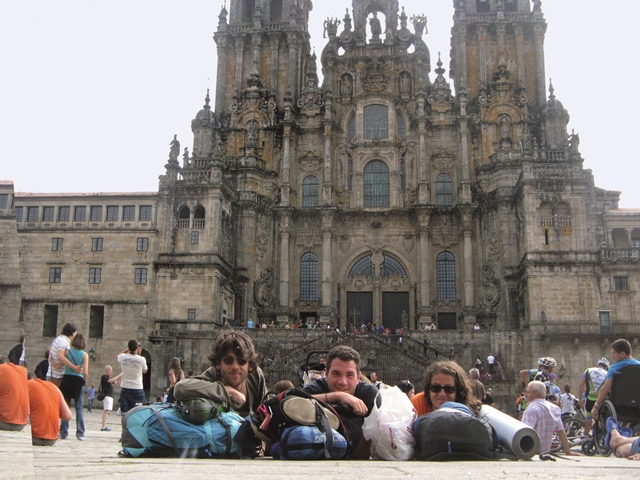
The end of the beginning
Santiago- I am surrounded by the happiness of all my friends who are already here. Some kick off their shoes out of sheer joy and walk barefoot. I enter the city and I am greeted by the bagpipes which are typical for Galicia. As I am lying on the tiles in front of the church and feel like I am home I am grateful. I am one with the people, the city, God and the universe. I am grateful and I take pictures of myself. I embrace the other "survivors"- friends or just people I have passed when I was travelling. I hug even those I see for the first time.
"Survivors" is not an over exaggeration- there are people who lost their lives along the way- their graves bear silent witness. Others cannot continue due to disease or some other problems. I had been walking with a girl for a whole week when she found out in front of my very eyes she was pregnant and had to go back.
The arrival at Santiago is a symbolic ending. In the cathedral
I see Saint Jacob's grave and I embrace his statue and I thank him for his protection. "Alpha and omega" is written, but in reverse, on the Roman side of the building. It means that the end of the journey is the beginning of a new one in peace with oneself and Him. And this one is endless, for eternity. The most enthusiastic pilgrims go all the way to Finistere. There, near the lighthouse, at sunset I set one of the few remaining clothes on fire- an act that symbolises I have left my sins behind and I am now free from their burden. Forever.
This journey is different. For it you would need a month off, the smallest backpack possible with just the basic necessities, some cash and an adventurous spirit and enough will to walk step by step along the 850-kilometre-long road in Northern Spain. Some use a horse- I look like Pippi Longstocking but I decide it is not my thing. I am not familiar with the art of maintaining a bicycle so I find walking the most "zen" of all. The road is me and I am the road. There are the landscapes, described by Cervantes, Quevedo and Hemingway. I am setting off and I do not know what is awaiting me, when and where I will be sleeping and/or eating, I am wondering whether I will get lost. It looks like a big adventure. Yet everything falls into its place and in the end I have no questions at all- just inner peace and a heart, filled with the incredible sights, meetings and adventures. Camino really is an experience. The road is a symbol of life in its entirety. On the road to Santiago I meet people who cover the distance again and again, some of them even settle here, they find home, love- they turn it into the meaning of their life. The Journey really is the meaning, isn't it?!

Sometimes you walk with a stranger without talking and that counts as nice and normal. Everyone has their own problems to think about but you are still not alone.
World's end
Saint Jacob, one of the closest disciples of Jesus Christ, spread the Word of God from Jerusalem all the way to Finistere (from Latin- finis terrae - the end of the world) situated on the coast of the Atlantic Ocean. On his way back to the holy lands, Saint Jacob was taken captive and executed. His followers decided to hide his body at the place he had been preaching- at the end of the world. His remains ended in a cave close to Finistere.
In the IX century the shepherd Pelayo noticed a strange light coming from underneath the ground. The rumour spread quickly and reached King Alfonso II who sent his people. They found the cave with a marble column in the middle which was emitting the rays. A chapel was built on the very spot which marked the beginnings of the town of Santiago de Compostela.
When and Who
There are pilgrims taking this route all year round but in winter the backpack is heavier. Most people come in August. I find it most convenient to travel in September as that is the time when there are a lot of wild apples, peaches, blackberries and walnuts along the road, ready to be picked. Furthermore the heat is so unbearable. Anyone who is in good health and wants to, regardless of age and nationality, can go. I meet a Japanese man who is travelling around the world with his children aged 7 and 9. After the earthquake he sold everything and just set off. There are a lot of other people: Bulgarians, who have come here hitchhiking, a grandmother and her granddaughter, some elderly people from Hawaii, a married couple, a mother and her daughter, people, who have found love on their way, priests from Poland or Norway. Most travellers, however, come from Spain, Germany, France, Italy and Brazil.
According to the legend, Saint Jacob was seen by many people after his death. His name is a symbol of rebirth and courage. That is why over the centuries millions of followers have chosen to follow in his footsteps along the road to Santiago. In the past they used the stars for navigation. It is believed that the route starting from the small French village of Saint Jean Pied de Port is a mirror image of the Milky Way.
In the beginning mostly the rich could afford this journey. Many of the travellers lost their lives to decease or robber attacks. Even today there are things that remind us of how it used to be - in my year it was bedbugs. It is a dangerous little bug which usually lives in mattresses but could easily find its way into your backpack for you to carry back home. I do not find this idea appealing so I buy a spray and whenever I go, I put my backpack in a plastic bag to keep it safe.
Following the Islamic invasion in Europe, Santiago was the city where the Reconquista began and that is why it has become a symbol of New Spain. In its cathedral there is a portrait which shows Saint Jacob oppressing the muslins. Nowadays the image is covered with flowers out of respect for the different beliefs.
During the First and Second World Wars the pilgrimage stopped, only to live to its Golden Age, which started in the 70s and has been going on until today.

Alto del Perdon- The peak of forgiveness, 735 meters- a windy hill 13 kilometres after Pamplona. Metal sculptures symbolize the never- ending journey with a sign that says: "Where the journey of the wind meets the journey of the stars
Credential
The routes are different, starting from Portugal, Germany, Poland or Madrid and then following the north coast of Spain. The original however is considered to be the one from Saint Jean Pied de Port.
Many people begin their journey on foot from Spain, France, even Germany, because the real pilgrim starts from his home. Of course, there is no way that I could start from "Simeonovsko shose" street and I choose a low-cost flight (worth 70 Euro) to Madrid. From there I take a bus (the ticket costs 22 Euro) to Pamplona. The journey takes five hours and looking out of the window I catch a glimpse of the occasional pilgrim with a backpack and a tourist walking stick. Hooray! I am not the only one. The last trip is to Saint-Jean and although the distance is only 80 kilometres, it takes two hours to cover. In the French village I go to the pilgrims' centre and buy myself a "pilgrim's passport" or the so called credential. Seals are placed here along the way to certify that I have indeed covered all points of the route. In the past the credential offered the travellers certain benefits, for example tax reduction. There are some restaurants even today that offer discounts, too. I put a mussel shell on my backpack- a sign that I am now officially a pilgrim. The tradition dates back to the times when the pilgrims used to take sea shells from the Atlantic coast as a souvenir for their relatives as well as to prove that they had reached the ocean. Now that has been replaced by a certificate in Latin stating you have walked the entire way. Actually, if you only walk the last 100 kilometres (or 200 if you are on a bicycle) you could still get a certificate. That is why the number of pilgrims is visibly higher towards the end. This is a good option if you cannot afford to take 30 days off. A lot of Spanish people travel the route little by little every year depending on the days they get off from work. Luckily I have 25 days, a little bit less than I need but I hope I can manage.
Haste makes waste
Here I am- I am making the first steps. The mussel shell is hanging on my backpack, the credential lies in my pocket and I am eager to meet the unknown which is waiting for me. I know I do not have much time so I hurry and hurry and hurry... As a result my ankle gets swollen on the third day and I have to make a stop. Sitting on some meadow, I decide it is not worth it. From now on I am not going to hurry even if it means not making it to the end.
And this is where the real journey starts and I begin to pay attention to the world around me and its miracles. This is not a race and therefore it is not important to be the first one to finish, but to finish.
My advice for you is to get more than 30 days off. It is better to have a day or two to rest at a place you particularly like or even better - to spend more time with your new-found friends on the road.
And also to spend more time with Him. God is everywhere but here of all places you sense His help and presence. You feel it not only in the numerous cathedrals, cultural and religious monuments which take your breath away; it is art created in the name God in form of gothic sculptures ceilings and frescos. This incredible beauty, the patience and diligence that were required in the making, the style and the ornamentation are an overload to my senses for which they are simply not prepared and I find myself breathless. The cathedral in Burgos is an enormous yet exquisite jewel which your poor senses cannot fully comprehend. The houses of Gaudi in Leon and Astorga, Roman walls, the citadel in Pamplona and many more monuments and monasteries are there to remind us that mankind is capable of miracles.
God is also in the chance meetings, in the attitude of the local people towards you, in the amazing sceneries. If we do not believe in coincidences then here we will be surprised at the miraculous chain of events. Your mind is emptied of all stress, my heart opens, my thoughts calm down and I breathe in the Spirit of God with every step I take.

Manharin, a shelter with no running water or electricity but it is believed that everybody who spends the night here is cured of any pain, thanks to the energy the place has. It is true!
A perfect machine
I soon feel the joy that comes from realizing the fact that the only job I will have to do in the next two, three, ten, twenty-five days is walking. This is a job I manage well. I do not have to think constantly about what I have to do, I do not have to make any calls, I just keep walking and I embrace the adventures coming every given moment. At night I have the wondrous feeling that I have achieved something. At first the body resists- ankles and knees begin to swell. That is why it is important to drink a lot of water- otherwise inflammations of the ligaments may occur.
I listen to my body as it is the only thing I have and after a week I feel in awe of the work of God. He has created the perfect machine out of mud – in just a few days my body has adjusted to the weather, the food and my new pace and it can cover 30- 35 kilometres a day even if though it has spent a year sitting behind a desk. My body is strong, fast and healthy - just 10 days after I started I feel like I could go on forever. At this point I understand how some people may cover distances of 3000 kilometres and more.
The original route I follow is wonderful- mountains, vast fields, small villages and big cities, fantastic cathedrals and museums, wilderness- you can find absolutely anything! There are yellow signs marking the way so there is almost no need for maps or guidebooks. All you need is a list with the names of the villages you should visit, the places to sleep and the distances between each one. And that is it.
I follow the signs and I wonder why there are none in real life to indicate the right path.
By chance I hear a mass in a small church. I do not speak Spanish but I understand the language. The pastor calls the route a symbol and a reflection of real life. At first, when you begin climbing the Pyreneans, just like at any new beginning in life, your heart is filled with bravery and great enthusiasm.
Relationships
Everyone says it is best to walk on your own and that turns out to be true. I walk at my own pace, I linger here and there for as long as I want to without having to give reasons or show consideration to others. It is not dangerous to travel alone, besides there is always someone who catches up with you or you approach someone else. We are never alone although sometimes we feel that way. It is easy to make friendships on the way. Someone comes by and we begin talking about the important things in life right away, other times we simply introduce and then go our separate ways. The true power of Camino is not in the cathedrals, the folklore and the priests; it is in the unique friendships we make. What we have in common is the sense of adventure, the need to run away from our everyday lives, the comfort, the system and the matrix; we share a love of freedom, dreams, idealism, loyalty and compassion, to desire to be one with nature, God and the others. With time I start to develop my intuition when it comes to the people. One early morning, when it is still dark, I meet a woman. She moves as a very fast pace but I can tell that she is tired. She asks for my name and I answer "Iva" at which she asks "Iva or Eva?" as if I could make a mistake with my own name. I immediately realize she is a teacher and indeed she really is one. We all greet each other with "Buen Camino!". Although we all speak different languages we understand each other.

Catering
The first days I have poor appetite and I do not sleep well- maybe I am tired or over-excited. You can eat the so-called "Pilgrim menu" everywhere. It consists of a salad or soup, tortilla or meat/fish with potatoes and a desert. To that you get a bottle of wine (which may eventually prevent you from continuing on your way) and a bottle of water and all of this costs 8-9 Euro. You eat a lot- that is for certain, but fortunately, nothing is accumulated as the calories are all burned. There is usually a kitchen at the albergues where you can cook. If you want to know where the cheapest shops are, just ask the local people. There is always a bar where I buy some huge sandwiches called bogadillos, which have a big variety in taste, some water, coffee, beer or a glass of wine. There are fountains along the way to fill your bottle with fresh water. You do not need more than a litre because the next fountain is not so far away.
There are ups and downs, everything is fresh and interesting and the joy that you have started on this path is great. It is more difficult when you go uphill. Step by step, you reach Spain, the Basque country and Navarra- a beautiful and rich region.
It is the end of July and I get the chance to visit the festivals in honour of Saint Firmin- which includes the famous Bull Chase game which taking place in Pamplona. You can eat and drink to your fill day and night, for a whole week. Everybody wears a red scarf around their necks to pay their respect and honour the sufferings of Saint Firmin.

A wine fountain
After Estrea comes La Rioja- a wine region. The place welcomes me with a wine fountain- free of charge! Everybody can fill a glass and try it and whether you are going to fill a whole tube or just a little bit of the magical elixir- it all depends on your conscience. And then you reach endless vineyards and milky-yellow Fields with curious deer running by, plains, small villages... and the heat becomes unbearable. The initial enthusiasm is replaced by sore feet, fatigue, and blisters. It takes persistence and strong will to keep going.
Every night, as soon as I arrive at the hostel, I clean or as they say "stitch up" the blisters. You cannot go without them. The blister is pierced with a needle and a thread, which goes through it and is left there so that the liquid can pour out. Then some iodine is put on it and in the morning it is dry and it does not hurt. One night I am so tired I have no strength left to wash my face, not to mention my blisters. Some boy tells me I must do it and I answer "Tomorrow, now I am going to sleep." "I will take care of them, do not worry." I have no energy to argue so he stitches them while I am asleep. We never meet so that I could thank him. A few days later, however, I take care of the feet of a complete stranger myself.
Some magnificent cities follow: Los Arcos, Logroao and Najera, each one of them having its own historic monuments, sceneries and legends.
There are small villages which are all special in their own way and have unique history. Many of them remind me of a set in a movie as I usually enter during the siesta time. This is a great Spanish "invention" - the heat is so unbearable that life virtually stops between 1pm.and 7pm. and everybody rests. There is the welcoming sight of houses, flowers and a church but it is still life – there are no people. One of the villages, Granon, at first sight appears to be like any other but the locals there have thought of a great ritual. The pilgrims cook whatever they can and then they bring it to the local bakery. The meals are then cooked but in order for us to get it, we must come up with a small performance. That way the locals get to watch a free show every day.

Bogeyman
I get up at 4.30-5 in the morning to avoid the heat.
I also have a midnight walk in a village at full moon, I arrive at around 3 o'clock and I sleep in front of the church- it makes me feel like I am in the Middle Ages. I reach Atapuerca where the remains of the first Europeans were found. They are archaeological evidence that the first settlers on the continent were also cannibals. It is as well the place where the oldest human jaw was also found. After the end of the village you can see a huge metal cross which looks eerie in the light of early morning when the moon is still shining. It is surrounded by spirals of white stones made by the people passing by. It is the break of dawn and it is rather chilly. The path varies between asphalt, dusty roads, wood tracks, stone paths. After 10 kilometres of industrial zone I reach Burgos. Some people are on their way to work, some are taking part in the protests, while others are drinking their morning coffee, and I look like an uncivilized version of Bogeyman- I am carrying a backpack and a walking stick, my face oily with sunscreen and a scarf over my head. Yet, nobody cares.
One of the most beautiful Spanish cities welcomes me the way I am. The city slowly reveals its beauty - its unique cathedral, the "De Las Huelgas" monastery, the arch, its colourful buildings, the small streets bustling with tourists, the magnificent river park... Here, in the city, you could easily tell who is a pilgrim and who is not- even without the tell-tale backpack. It is the walk that gives them away. All the pilgrims walk in the same strange, ungainly, almost ridiculous way because of their blisters and aches.
Messina
Day after day I walk between 25 and 35 kilometres and I realize that no matter how much one day resembles another, they are all unique. Sometimes I sing from the top of my lungs, I talk to myself, I talk to the eagles or I recite poetry. Everyone cries at least once- the catharsis eventually gets you, sooner or later.
You reach the middle of the road, called the messina. It is a 17-kilometer long deserted road- there is no water, no food, no shelter from the sun and no people.

Shelter
We sleep in the so-called alberges. They remind me of our tourist shelters and huts, the rooms usually have bunk beds and belong to the municipality or the church, but there are also private ones. One alberge is housed in a former theatre, another one is run by some hippies and a third one looks like a Mexican farm. It costs 5-10 Euro, the more picky ones can sleep at a hotel, hostel or private accommodation. The alberges have kitchens, showers with hot water, a toilet and sometimes a pool. Usually men and women share a room. The snoring at night is the same in any language- a symphony of tones, so earplugs are a must-have.

Serbreiro - the common houses for Galicia have straw roofs
Costumes and props
The legend goes that you carry your sins in your backpack. The bigger it is, the more things you are attached to, which weigh you down. The light backpack is a must - there are some wonderful specimens in sport shops to choose from. At the end of the second day I threw away half the things I had packed, I also sent some stuff to friends of mine in Madrid. I fully understand how little is needed to live well. Every night I wash my clothes using soap, if I have one, and the next day I let them dry on my backpack while I am walking. With me I carried a sleeping bag (compact and light-weight), two pairs of shorts, one pair of trousers, two T-shirts, a jacket, raincoat, a pair of shoes, a pair of sandals, two pairs of socks, safety pins (for the clothes drying on your backpack), liquid detergent, a bar of soap, sunscreen, a needle and a thread, a hat. The luggage should not be more than 10% of your own weight. To that you add water, a little bit of food, a notebook and a pen and you are ready. I had also brought three books, two of which I left on the way and I sent the third back. The most important thing are the shoes! They have to be hiking boots so as not to have sore feet. Remember – shoes must be comfortable.
I get the feeling I will never reach the end. There is still a long way to go before I reach my goal, I am starting to lose track of time. My mind is blank and I just walk, following the yellow arrows which point only one way- forward. I have a goal even if it seems unreachable now. In life it is the invariable everyday obstacles and the routine that make me give up when I should not.
I am left alone with myself and I have a lot of time on my hands for sorting my priorities. This is how I usually find the solutions to the various problems of everyday life. Every step I take teaches me to be patient and persistent. Sometimes, when I am soaking wet with sweat, and I am walking across a field without a single tree to offer shade from the beating sun, I wonder why I started all this, why am I doing this to myself while my friends are lying on the beach with a beer in their hand.
Then I meet Minho- a Korean who is travelling along the Camino for the third time. I joke "Why, Minho?" "When you reach Santiago, you'll know" And so it was.

I never give up. I keep walking and every day is like the one before. Costilla and Leon are the regions with the most monotonic landscapes of all, but they also offer the greatest number of historical and cultural monuments in Spain. Leon, for example boasts a beautiful cathedral, some small squares where elderly dressed up ladies are discussing the crisis and men are laughing out loud while drinking cerveza, beautiful young people are walking around and countless flowers are covering the windows. Astorga- there is not a single thing that is not worth taking a shot- the city hall, the clock, the park. The Bishop's palace, built by Gaudi in 1887, is now known as the Camino museum with numerous relics and manuscripts. The lady at the entrance, who checks the tickets, is called... Camino.
Every village has built its own monument dedicated to the pilgrims- such variety and imagination!
Love
Accidentally I hear a sermon given by a Franciscan monk- he immediately wins me over as he reminds me of my favourite teacher- Koko Azaryan. We enter the church and he asks us whether we want to take home the peace we have found on our way to Santiago. We all answer "yes". And he continues: "Which do you think is the symbol of the Christian faith?" Everyone says "The crucifix, the cross", only I say "Love". "If it is the crucifix, then who wants and desires to be crucified? Love is the true power of the Christianity. That is why you should always greet with an open hand, just as you do here. Hold out your hands to the others and even if someone is getting on your nerves, you should encourage them instead of pecking them back." - this is what the monk tells us.
It is as simple as that! A religion so closely connected to real life! Not just a far-fetched sermon but a true connection between faith and life. In order for us to preserve the peace in our hearts we must show our love to our brothers and sisters- it is easy, but we do not always do allow ourselves the liberty to do so.

Pedalling
You could also cover the distance on a bicycle for about 10 days. When you arrive in Madrid, the bike gets on the bus with you. You should also take some essentials in case of flat tyres like keys and screwdrivers. You should also train your body for the upcoming 70-80 kilometres a day you are going to cycle every daily. Take some bright and light clothes, which reduce the rubbing and mind the traffic regulations.
I want Galicia
Finally I enter the last and most beautiful regions of all- Galicia. It serves as a reward for my perseverance. Yes, it may drizzle, but this is how Galicia is- wet and beautiful. After the extreme heat I have been through this is a blessing. I am walking across some fantastic green fields, animated houses with thatched roofs and century-old forests. The landscape is constantly changing and my brain is happy about it. It needs variety and after the long transitions through nothingness I am once again full of my initial enthusiasm. But I am different now- much more open to the world, much more relaxed, much closer to my goal.
The experiences become much more intensive, the new-found friendships become love and I feel almost reluctant to reach Camino because I know reaching the goal means the end of something. This is where the vacation will end, the peace I found will disappear, I will have to say goodbye to those wonderful people I have met, the ones I walk every single day with...

The end of the beginning
Santiago- I am surrounded by the happiness of all my friends who are already here. Some kick off their shoes out of sheer joy and walk barefoot. I enter the city and I am greeted by the bagpipes which are typical for Galicia. As I am lying on the tiles in front of the church and feel like I am home I am grateful. I am one with the people, the city, God and the universe. I am grateful and I take pictures of myself. I embrace the other "survivors"- friends or just people I have passed when I was travelling. I hug even those I see for the first time.
"Survivors" is not an over exaggeration- there are people who lost their lives along the way- their graves bear silent witness. Others cannot continue due to disease or some other problems. I had been walking with a girl for a whole week when she found out in front of my very eyes she was pregnant and had to go back.
The arrival at Santiago is a symbolic ending. In the cathedral
I see Saint Jacob's grave and I embrace his statue and I thank him for his protection. "Alpha and omega" is written, but in reverse, on the Roman side of the building. It means that the end of the journey is the beginning of a new one in peace with oneself and Him. And this one is endless, for eternity. The most enthusiastic pilgrims go all the way to Finistere. There, near the lighthouse, at sunset I set one of the few remaining clothes on fire- an act that symbolises I have left my sins behind and I am now free from their burden. Forever.

